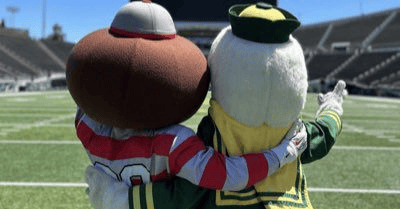By Andrew Jenck
Laying on the shores of the Pacific lies the Pac-12, “Packy,” having been dealt blows to its upper left forehead, and three more, south of its stomach. It got hit hard, having its ankles broken last year when USC and UCLA ditched and hooked up with the Midwest crowd — the “Big 10.” This year, it got hit in the chest as Colorado reunited with its ex, the Big 12. Most of its posse followed their path: Oregon, Washington, Arizona, Arizona State, and Utah have left for either one of those gangs. Now there’s rumblings of Cal and Stanford heading east for the ACC. Although still kicking, ole Packy’s hanging by a few threads, made from beaver and cougar fur. The nurses really need to expand their operations to keep that now four-piece conference going. So how did it come to this? How did the Conference of Champions, one of five powerful college units crumble? Who’s the punk that tried to murder the Pac-12?
To answer, we have to swerve to the past. Way back to 2012, the year of new deals. Whereas Big 10 was getting cozy with a lady named Foxy, Packy went solo. Unlike other gangs where the top dog takes the biggest cut, Packy split the earnings evenly, where even that buff poser Oregon “Puddles” Duck wouldn’t receive a dime more than its farm-kid cousin from Corvallis. From day one, the territory of the network was limited. They lacked many providers while Foxy had all the cable carriers by the ringer. Packy fell back further when that controller, E.S.P.N., made moves across the Southeast and Atlantic, providing millions to their sweethearts. Unlike the other U’s, Packy’s 12 fully owned the channel but was making less dough. Foxy and Espy provided all the goods, for the schools. Former head honcho Larry Scott was certain that building in-house would give them all the moola, but he failed to deliver the revenue , which ain’t a good look for those flashy LA punks.
The follow up boss, George Kliavkoff, needed to glue back the vase but he was unknowingly stepping on the pieces. George had an overcooked meal on his plate: couldn’t play off against bigger guns and weakened when the cops strung up the Trojans for its recruiting schemes. In just a few years Big 10 began intertwining with the dealer Peacock and that all-seeing eye CBS. A cog came into the system when the Longhorns and Sooners were heading Southeast, leaving Big 12 vulnerable. Packy should have gone aggressive and swiped some of their bouncers, like Buffalo a decade prior, but George went soft, keeping on the defense when he should’ve been playing hard ball. The LA boys wanted a taste of that sweet Midwest corn and packed up to join the Big 10. Regional alliance be damned. Even with the muscle gone, George thought he had teams on the same page and got too cocky, wanting more from ESPN than $30 million only to see them walk away. Best he could get was from some silicon apple for, at most, $20 mill, if they’re feeling generous. This sent the big guys packing, leaving only the country kids and prep students from the Bay. George was given a raw deal, but even he could’ve cooked up something better than this crapshoot.
So, we’ve flipped through the script, now what’s the third act reveal? Big 10 is our prime suspect; this shark swiped Packy’s big guns. Big 12 is no angel either. Their territory got crouched on, so they south pawed the 12 by taking five. ESPN and Fox were beneficiaries, leaving Packy to dry up, while their revenues skyrocket with these new mega-gangs. So, which of these chumps is the attempted killer? No one. We’ve been asking who, when we should have been asking what. And what killed Packy was unhinged capitalism. The changing times of students getting paid, and the transfer portal ramped up spending; Packy was too slow to keep up. Management assumed traditions would hold but a few blank checks erased that history. These big gangs needed to combat the top wizard, SEC, and ate up anything for survival. This was a brass knuckle fight and Packy just brought lightweight boxing gloves. What’s happened to the PAC-12 is pure tragedy, taken down by overcharged TV rights in an industry that veered off too fast. It’s yet another piece of evidence for the dark truth of sports: it’s less about who plays the best calls, it’s who has the biggest checkbook.
Case closed.


